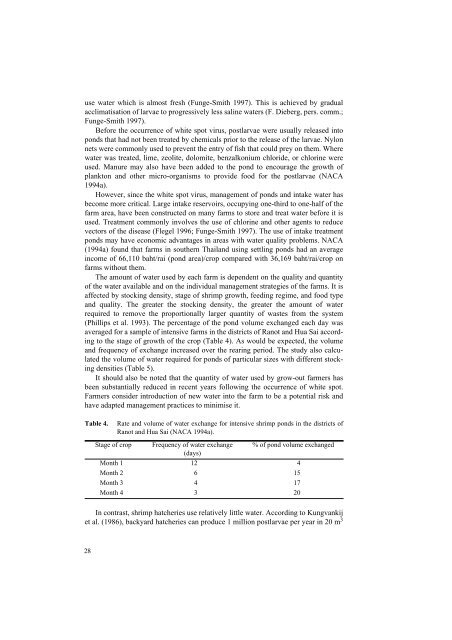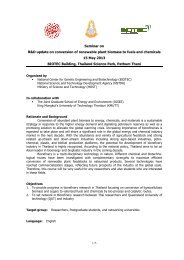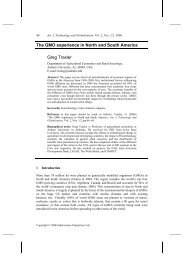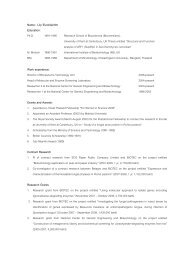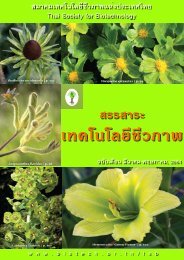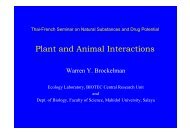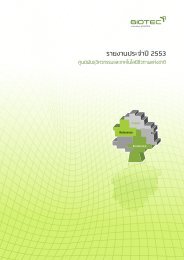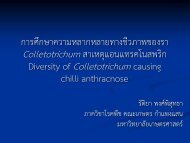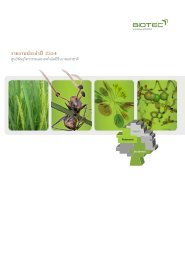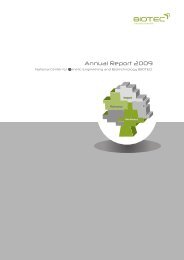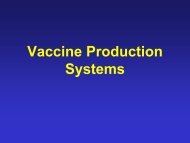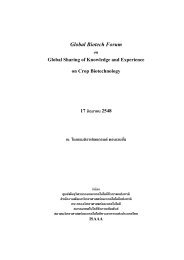Coastal Shrimp Aquaculture in Thailand: Key Issues for Research
Coastal Shrimp Aquaculture in Thailand: Key Issues for Research
Coastal Shrimp Aquaculture in Thailand: Key Issues for Research
You also want an ePaper? Increase the reach of your titles
YUMPU automatically turns print PDFs into web optimized ePapers that Google loves.
!use water which is almost fresh (Funge-Smith 1997). This is achieved by gradualacclimatisation of larvae to progressively less sal<strong>in</strong>e waters (F. Dieberg, pers. comm.;Funge-Smith 1997).Be<strong>for</strong>e the occurrence of white spot virus, postlarvae were usually released <strong>in</strong>toponds that had not been treated by chemicals prior to the release of the larvae. Nylonnets were commonly used to prevent the entry of fish that could prey on them. Wherewater was treated, lime, zeolite, dolomite, benzalkonium chloride, or chlor<strong>in</strong>e wereused. Manure may also have been added to the pond to encourage the growth ofplankton and other micro-organisms to provide food <strong>for</strong> the postlarvae (NACA1994a).However, s<strong>in</strong>ce the white spot virus, management of ponds and <strong>in</strong>take water hasbecome more critical. Large <strong>in</strong>take reservoirs, occupy<strong>in</strong>g one-third to one-half of thefarm area, have been constructed on many farms to store and treat water be<strong>for</strong>e it isused. Treatment commonly <strong>in</strong>volves the use of chlor<strong>in</strong>e and other agents to reducevectors of the disease (Flegel 1996; Funge-Smith 1997). The use of <strong>in</strong>take treatmentponds may have economic advantages <strong>in</strong> areas with water quality problems. NACA(1994a) found that farms <strong>in</strong> southern <strong>Thailand</strong> us<strong>in</strong>g settl<strong>in</strong>g ponds had an average<strong>in</strong>come of 66,110 baht/rai (pond area)/crop compared with 36,169 baht/rai/crop onfarms without them.The amount of water used by each farm is dependent on the quality and quantityof the water available and on the <strong>in</strong>dividual management strategies of the farms. It isaffected by stock<strong>in</strong>g density, stage of shrimp growth, feed<strong>in</strong>g regime, and food typeand quality. The greater the stock<strong>in</strong>g density, the greater the amount of waterrequired to remove the proportionally larger quantity of wastes from the system(Phillips et al. 1993). The percentage of the pond volume exchanged each day wasaveraged <strong>for</strong> a sample of <strong>in</strong>tensive farms <strong>in</strong> the districts of Ranot and Hua Sai accord<strong>in</strong>gto the stage of growth of the crop (Table 4). As would be expected, the volumeand frequency of exchange <strong>in</strong>creased over the rear<strong>in</strong>g period. The study also calculatedthe volume of water required <strong>for</strong> ponds of particular sizes with different stock<strong>in</strong>gdensities (Table 5).It should also be noted that the quantity of water used by grow-out farmers hasbeen substantially reduced <strong>in</strong> recent years follow<strong>in</strong>g the occurrence of white spot.Farmers consider <strong>in</strong>troduction of new water <strong>in</strong>to the farm to be a potential risk andhave adapted management practices to m<strong>in</strong>imise it.Table 4.Rate and volume of water exchange <strong>for</strong> <strong>in</strong>tensive shrimp ponds <strong>in</strong> the districts ofRanot and Hua Sai (NACA 1994a).Stage of crop Frequency of water exchange % of pond volume exchanged(days)Month 1 12 4Month 2 6 15Month 3 4 17Month 4 3 20In contrast, shrimp hatcheries use relatively little water. Accord<strong>in</strong>g to Kungvankijet al. (1986), backyard hatcheries can produce 1 million postlarvae per year <strong>in</strong> 20 m 3+'


